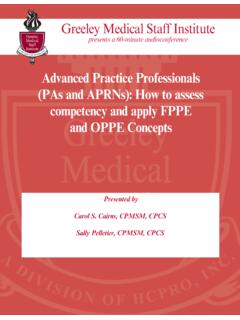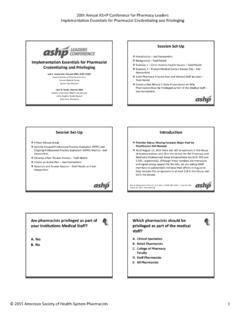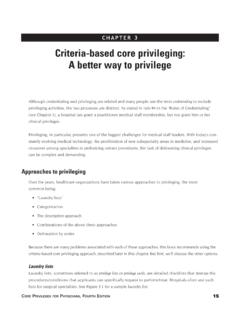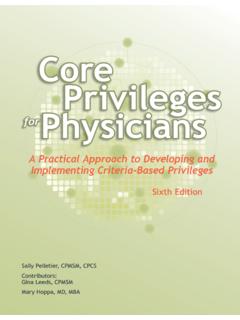Transcription of Guidelines for Core Clinical Privileges - Cana, California
1 American Association of Nurse Anesthetists 222 South Prospect Park Ridge, IL 60068 Copyright 2005 Guidelines for core Clinical Privileges Certified Registered Nurse Anesthetists American Association of Nurse Anesthetists 1 Guidelines for core Clinical Privileges Certified Registered Nurse Anesthetists Introduction Clinical privileging is the process through which individuals are credentialed within institutions to provide specific patient care services. Credentialing may be defined as the recognition of professional and technical competence and well defined criteria - based mechanisms to verify information and evaluate the applicant requesting Privileges . core Privileges define the scope of the procedure and activities within a specialty that each practitioner has the education, experience and current competence to perform.
2 Nurse anesthesia is an advanced Clinical nursing specialty based upon a graduate level curriculum focused on development of Clinical judgment and critical thinking. CRNAs are qualified to render patients insensible to pain and emotional stress during surgical, obstetrical, diagnostic and invasive procedures utilizing general and regional anesthesia and all levels of sedation techniques. core Clinical privileging is an institutional or agency credentialing process, usually administered by the medical staff or other equivalent process of the institution. Certified Registered Nurse Anesthetists (CRNAs) should be granted core Clinical practice Privileges consistent with other healthcare professional staff members who are permitted by law and the facility to provide patient care services. The credentialing and privileging process should provide an objective mechanism for initial application and renewal of Clinical Privileges based on education, experience, legal qualifications and an assessment of the individual practitioner's competence and ability to render quality care.
3 CRNA scope of practice is dynamic and evolving. Privileges should be appropriate to the scope and complexity of care provided by CRNAs. Clinical privileging should be so defined as to permit the CRNA to provide core procedures and selected activities under specific conditions with or without supervision. The Clinical privileging process includes: (1) the qualifications of the provider; (2) the actual practice Privileges requested and granted; (3) the conditions or limits of practice; and, (4) the process for assessment of quality of work and renewal of Privileges . Qualifications Basic qualifications for Clinical Privileges shall include: 1. State licensure as a registered professional nurse. Compliance with state and federal requirements for the advanced practice of nurse anesthesia. 2. Graduation from a program of nurse anesthesia education accredited by the Council on Accreditation of Nurse Anesthesia Educational Programs or its predecessor.
4 3. Certification by the Council on Certification of Nurse Anesthetists or recertification by the Council on Recertification of Nurse Anesthetists or their respective predecessors or, if pending initial certification, evidence of graduation from the Council on Accreditation of Nurse Anesthesia Educational Programs approved program. American Association of Nurse Anesthetists 24. Compliance with relevant requirements for continuing education, competence in advanced life support (adults, children and neonates as applicable), and listing pertinent education, training or expertise in specialty areas ( , fiberoptic intubation). 5. Provision of information as to whether certification, licensure or Clinical Privileges have ever been denied, revoked, or suspended. 6. Attestation of physical and mental abilities to perform requested Privileges .
5 7. Proof of medical malpractice appropriate for limits required by the institution or state. 8. Evidence of National Practitioner Data Bank query. Recommended core Clinical Privileges CRNA Privileges and responsibilities must be consistent with law and may without limitation, include the following: Preanesthetic Preparation and Evaluation y Obtaining an appropriate health history. y Conducting an appropriate physical screening assessment. y Recommending or requesting and evaluating pertinent diagnostic studies. y Selecting, obtaining, ordering, and administering preanesthetic medications. y Documenting the preanesthetic evaluation and obtaining a comprehensive informed consent for anesthesia and related services. lntraoperative Care y Obtaining, preparing, and using all equipment, monitors, supplies and drugs used for the administration of anesthesia and sedation techniques, performing and ordering safety checks as needed.
6 Y Selecting, obtaining or administering the anesthetics, adjuvant drugs, accessory drugs, fluids and blood products necessary to manage the anesthetic. y Performing all aspects of airway management, including fiberoptic intubation. y Performing and managing regional anesthetic techniques including, but not limited to, subarachnoid, epidural and caudal blocks; plexus, major and peripheral nerve blocks; intravenous regional anesthesia; transtracheal, topical and local infiltration blocks; intra capsular, intercostal and ocular blocks. y Providing appropriate invasive and non-invasive monitoring modalities utilizing current standards and techniques. y Recognizing abnormal patient response during anesthesia, selecting and implementing corrective action and requesting consultation whenever necessary.
7 Y Evaluating patient response during emergence from anesthesia and instituting pharmacological or supportive treatment to insure patient stability during transfer. Postanesthesia Care y Providing postanesthesia follow-up and evaluation of the patient's response to anesthesia and surgical experience, taking appropriate corrective actions and requesting consultation when indicated. American Association of Nurse Anesthetists 3y Initiating and administering respiratory support to ensure adequate ventilation and oxygenation in the postanesthesia period. y Initiating and administering pharmacological or fluid support of the cardiovascular system during the postanesthesia period to prevent morbidity and mortality. y Initiating acute postanesthesia pain management techniques. y Discharging patients from a postanesthesia care area according to facility policy.
8 Clinical Support Functions y Inserting peripheral and central intravenous catheters. y Inserting pulmonary artery catheters. y Inserting arterial catheters and performing arterial puncture to obtain arterial blood samples. y Managing emergency situations, including initiating or participating in cardiopulmonary resuscitation. y Providing consultation and implementation of respiratory and ventilatory care. y Management of interventional pain therapy utilizing drugs, regional anesthetic techniques or other accepted pain relief modalities. y Using consultation when appropriate, selecting, obtaining, ordering and/or administering medications or treatments related to the care of the patient. y Accepting additional responsibilities which are within the expertise of the individual CRNA and appropriate to the practice setting.
9 Special Requests y Diagnostic and therapeutic injections with or without fluoroscopic guidance including epidural, caudal , spinal, facet joint, selective nerve, and sympathetic blocks. y Transesophageal echocardiogram. Non- Clinical Responsibilities It would be appropriate to describe additional CRNA responsibilities for any or all of the subheadings listed below. Administrative/management: scheduling, material and supply management, supervision of staff, students or ancillary personnel, development of policies and procedures, fiscal management, performance evaluations, preventative maintenance, billing and data management. Quality assessment: data collection, reporting mechanism, trending, compliance, committee meetings, departmental review, problem-focused studies, problem solving, interventions, documentation and process oversight.
10 Educational: Clinical and didactic teaching, BCLS/ACLS instruction, inservice commitment, EMT training, supervision of residents and facility continuing education. American Association of Nurse Anesthetists 4 Research: conducting and/or participating in departmental, hospital-wide or university-sponsored research projects. Committee appointments: assignment to committees, committee responsibilities, coordination of committee activities. Interdepartmental liaison: interface with other departments such as nursing, surgery, obstetrics, postanesthesia care unit (PACU), outpatient surgery, admissions, administration, laboratory, pharmacy, etc. Clinical /Administrative oversight of other departments: respiratory therapy, PACU, operating room, surgery intensive care units, pain clinics, etc. CRNAs are responsible for seeking Clinical Privileges that reflect their educational preparation, Clinical experience and level of professional competence.









